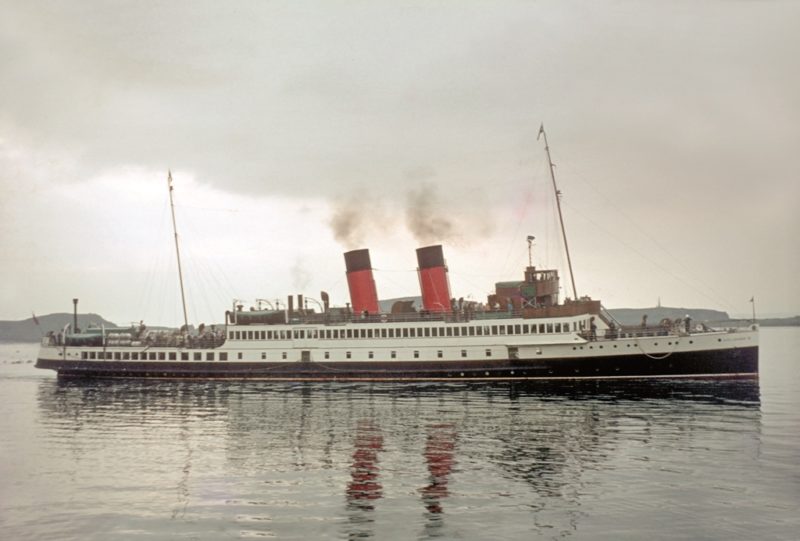
Part 1: David MacBrayne 1985 to 1973
The magnificent scenery of lochs and bays and the grandeur of the many mountains in the Western Isles led travellers to visit and settle over the centuries. The travellers on the early steamers in the first decades of the 19th century across The Minch to the Outer Hebrides fell into two groups. In terms of status, members of the first group comprised the Macleod clan of Dunvegan Castle in north west Skye and on Harris, and the Macdonald ‘Lord of the Isles’ clan with a base at Sleat on Skye. The Macdonald clan had controlled most of the North Minch basin since the 16th century, with many feuds with the Macleod clan, and their tenants of large rented farms were numerous. The second group of travellers included seafarers, fishermen, shepherds, farm workers, blacksmiths, herdsmen, bailiffs, bakers, stockmen, drovers, gillies (gamekeepers), kelp workers, teachers, ministers, doctors and nurses.
One of the more famous members of the Macdonald clan was Flora Macdonald (1722 -1790), who was visiting Benbecula in the Outer Hebrides when Bonnie Prince Charlie and a small group of aides took refuge there after the Jacobite Rebellion of 1745 and the Battle of Culloden in June 1746. Flora’s stepfather Hugh Macdonald controlled the pro-Government militia on Benbecula, and she was able to obtain the necessary permits to travel to Skye for herself, a boat crew of six men and two women servants, one of whom was Prince Charles in disguise, to land at Kilbride near Uig on Skye on 27th June 1746. The ‘Skye Boat Song’ relates to this passage across The Minch, and on the next day Prince Charles was taken from Portree to the Isle of Raasay, and thus evaded the many Government troops who were searching for him on Skye. He made good his escape on the French frigate L’Heureux and arrived in France in early September 1746.
One of the more famous members of the Macleod clan was Iain Macleod (1913-1970), who died while holding the high office of Chancellor of the Exchequer. He belonged to a branch of the Macleod clan of Pabbay and Uig on Skye and after graduating from university he became first a professional bridge player, and then a Member of Parliament in 1950. He worked in the Foreign Office as a Cabinet Minister and later was Minister of Health, Colonial Secretary (1959-1961) as well as Chairman of the Conservative Party (1961-1963). He is remembered for his colonial work and was the prime mover in the movement to grant independence to many British colonies in Africa in the 1960s, as he recognised the fervour of the wish for independence in Africa and thus saved the lives of many British troops who would have died defending the colonies during this period of upheaval. Dunvegan Castle was first built in the 13th century and developed piecemeal over the centuries, but it actually dates from the 19th century when it was remodelled as a ‘mock medieval’ castle, and it was opened to the public in 1933 with great views over Loch Dunvegan.
The first early wooden paddle steamer that went ‘All the Way to Stornoway’ from Glasgow was the Ben Nevis of 45 grt in 1828, sailing on alternate Tuesdays from Glasgow and using the Crinan Canal, with other small steamers on scheduled services as far as Skye. The steamer Mary Jane of 226 grt and overall length of 150 feet was a better seaboat to Stornoway when she was completed in 1846. She reached Stornoway from Glasgow in a little over 26 hours under Capt. R. H. Hudson in June 1846, and then undertook an excursion from Stornoway to show off her fine lines. The larger wooden paddle steamer Marquis of Stafford completed in 1849 operated mostly to Stornoway from Poolewe on the mainland in place of sailing ships.
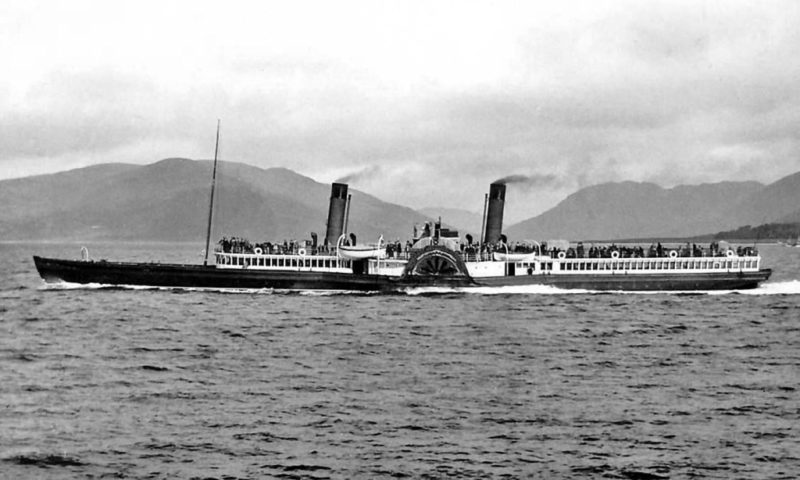
DAVID MACBRAYNE
David MacBrayne (1815-1907) was ‘the right man in the right place’ in February 1851 when the firm of David Hutcheson & Company was formed, the partners being David Hutcheson and Alexander Hutcheson, who had long been Heads of Departments in the G. & J. Burns fleet of Glasgow, and their nephew David MacBrayne. The company office was at 14 Jamaica Street in Glasgow, and they took over the West Coast of Scotland paddle steamers of the Burns Brothers of Dolphin, Pioneer, Duntroon Castle, Edinburgh Castle, Cygnet, Lapwing, and Curlew, together with two Crinan Canal track boats, Maid of Perth and Sunbeam. The new company thus had the support of the Burns family. One other paddle steamer was taken over on formation of the company in Shandon from Thomson & McConnell and their City of Glasgow Steam Packet Company. Inverary Castle and Rothesay Castle were taken on charter for two months for the run from Glasgow to Loch Fyne.
G & J. Burns had taken over the Clyde to Ardrishaig on Loch Fyne paddle steamer routes of the Glasgow Steam Packet Company in June 1846, with ‘Castle’ names of their ships e.g. Inverary Castle, Rothesay Castle, Toward Castle, Dunoon Castle, Arran Castle, Windsor Castle, Edinburgh Castle, Tarbert Castle, Duntroon Castle, Cardiff Castle, Craignish Castle and Dunrobin Castle, the latter the seat of the Duke of Sutherland. David Hutcheson & Company became the largest of the West Coast steamer owners and were to totally dominate the area, taking over the Glasgow & Loch Fyne Steam Packet Company and the Glasgow & Highland Steam Packet Company in 1857.
Their main two services were ‘All the Way to Stornoway’ by steamers of a more sedate speed via the Mull of Kintyre carrying cargo as well as passengers, and the ‘Royal Route to Inverness’ by fast steamers, as well as many smaller services on the Clyde and to the islands of the Inner Hebrides. Queen Victoria later travelled from Glasgow to the Crinan Canal and thus the ‘Royal’ epithet was added to the Inverness route, which in fact was a series of four voyages taken by different steamers on sometimes separate days to reach Inverness, the first being Glasgow to the Crinan Canal, the second being from the western exit of the Crinan Canal to Oban, and the third being between Oban and Fort William and Banavie, and the fourth voyage travelling along beautiful Loch Ness to Inverness. The traveller to Oban could then board another fast steamer to carry him north west to Gairloch via Mull and Skye, and cruises were operated to Iona and Staffa in summer from Oban.

The Islay service of John Ramsey and others was taken over in 1876, the year that David Hutcheson retired, and his brother Alexander two years later, leaving David MacBrayne as the surviving partner to operate the business under his own name from 1879. A total of thirty paddle steamers entered the company fleet from 1852 to 1910, with their dates of service in the MacBrayne fleet being:-
- Mountaineer (1852-1889) twin funnelled and lost by stranding on 7th October 1889
- Chevalier (1853-1854) and wrecked on Iron Rock, Sound of Jura on 24th November 1854
- Iona (1855-1862) and sunk in Gourock Bay by collision on 2nd October 1862
- Clansman (1855-1869) wrecked on Sanda Island in 1869
- Inverary Castle built in 1839 (1857-1891) and broken up at Bowling in 1892
- Mary Jane built in 1846 (1857-1931, renamed Glencoe in 1875) broken up in 1931
- Duke of Argyll built 1852 (1857-1858) sank in the Sound of Mull on 12th January 1858
- Stork built 1851 (1858-1861) and sold to the Italian Government in 1861
- Plover built 1849 as Maid of Lorn (1859-1879) laid up and rotted in the Gareloch
- Fairy (1861-1863) sold for further trading
- Iona (2) (1863) sold for blockade running for the Confederates in America
- Iona (3) (1864-1936) two funnels and broken up at Dalmuir in 1936 alongside Columba
- Gondolier (1866-1939) taken over by the Admiralty and sunk at Scapa Flow
- Chevalier (1866-1929) two funnels and broken up at Troon after 63 years of service
- Dolphin built 1849 as Islay (1868) lengthened and later sold off
- Islay built in 1867 (1876-1890) wrecked in Red Bay, Antrim in December 1890
- Columba (1878-1936) two funnels and broken up at Dalmuir in 1936 alongside Iona (3)
- Grenadier (1885-1927) twin funnelled and lost by fire on the North Pier at Oban in September 1927
- Lochness built in 1853 as Lough Foyle (1885-1912) sold for breaking up in 1912
- Fusilier (1888-1934) sold for further trading on the East Coast, broken up end of 1939
- Hero built in 1858 renamed Mountaineer (2) in 1892 (1890-1909) broken up in 1909
- Islay twin funnelled and built in 1872 as Princess Louise (1890-1902)
- Great Western built in 1867 renamed Lovedale in 1893 (1891-1904) broken up 1904
- Gael twin funnelled and built in 1867 (1891-1923) sold for breaking up in May 1924
- Cygnus built in 1854 renamed Brigadier in 1892 (1891-1896) wrecked on Duncan’s Rock near Rodel on 7th December 1896
- Carabinier built in 1878 as Albert Edward (1893-1909) broken up at Troon 1909
- Gairlochy built in 1861 as Sultan then renamed Ardmore (1894-1919) lost by fire at Fort Augustus 24th December 1919.
- Glendale twin funnelled and built in 1875 as Paris, later Flamingo and La Belgique (1902-1905) wrecked on Deas Point, Kintyre on 20th July 1905
- Pioneer (1905-1943) and sold to Admiralty
- Mountaineer (3) (1910-1937) broken up at Port Glasgow in September 1938
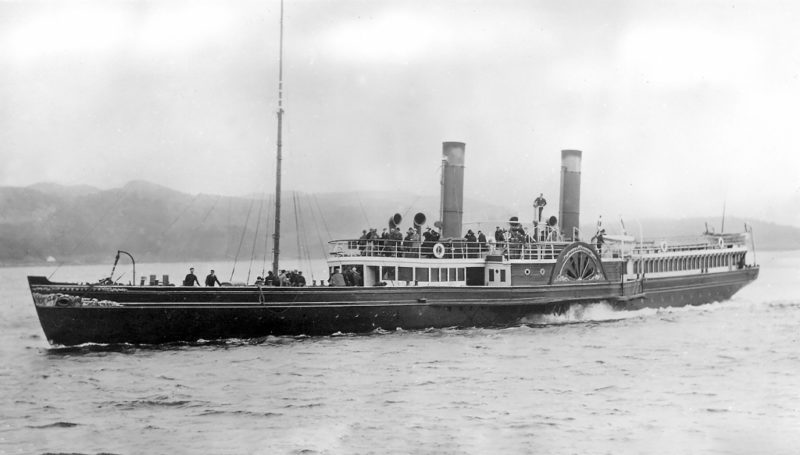
Columba of 1878 and 602 grt was by far the best looking paddle steamer in the MacBrayne fleet, and was twin funnelled with one funnel forward and another abaft her large paddle wheels, a single mast forward, counter stern, and four lifeboats above her aft saloon. She was a stretched version of Iona (3) of 1863 with an overall length of 301.4 feet, moulded beam not including the paddle boxes of 27.1 feet, and moulded depth of 9.4 feet, and her black hull was built of steel and launched at Clydebank on 11th April 1878 by J. & G. Thomson. The total cost being £28,000 with twin cylinder simple oscillating steam engines giving a service speed of 19 knots. She was held in high regard by all who travelled on her on the Clyde and West Coast, her low profile and twin red funnels with a black top making her almost instantly recognisable.
The screw steamers that entered the MacBrayne fleet were equally numerous, with Fingal of 463 grt built in 1861 for the Stornoway run, but she only lasted four months on the run along with Clansman, as she was sold for use as an American Confederate ironclad ram with sloping hull sides named Atlanta. She ran aground in Wassaw Sound in Georgia on 17th June 1863 and surrendered to Unionist forces who kept her name. She was decommissioned from the U.S. Navy on 21st June 1865, and loaded with munitions she sailed from Philadelphia for Haiti on 8th December 1869 but sank a few days later off Cape Hatteras.
The second MacBrayne screw steamer was Clydesdale of 468 grt completed in 1862 and later lengthened to 196.7 feet with a moulded beam of 24.1 feet and moulded depth of 13.5 feet, and she sailed for MacBrayne until 1904. The other MacBrayne screw steamers in the fleet up to 1890 included Ossian (1863), Staffa (1863), Linnet (1866), Clansman (2) of 1870, Queen of the Lake purchased in 1876 but built in 1863, Lochawe (1876), Islay (2) of 1867, Lochiel of 1877, Fingal (2) of 1877, Claymore (1881), Cavalier of 1883, Clansman (3) purchased as Ethel in 1885 but built in 1880, Handa purchased in 1887 but built in 1878, Mabel (1883), Gladiator purchased in 1887 but built in 1860, Udea purchased in 1888 but built on the Tyne in 1873, Staffa (3) purchased in 1888 but built in 1861, Pelican purchased in 1888 but built in 1850, Falcon purchased in 1888 but built in 1854, Margaret (1889), Texa purchased in 1889 but built in 1884, Loanda of 1,475 grt purchased in 1889 as a collier and later a coal hulk, and Flowerdale purchased in 1889 but built in 1878.
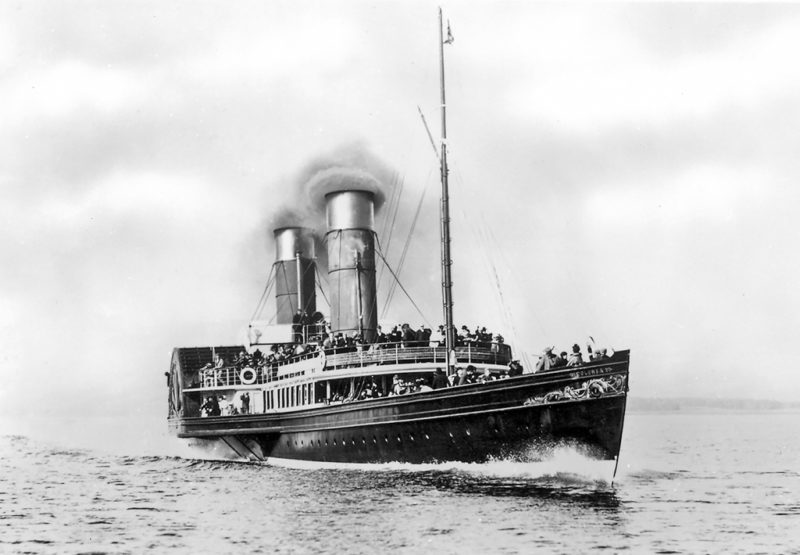
The loss of Clansman in late July 1869 on Sanda Island at the south end of the Kintyre peninsula was due to her grounding in dense fog on Sheep Island, a set of rocks west of Sanda while on a voyage from Stornoway to Glasgow on the ‘All the Way to Stornoway’ route. The one hundred passengers were safely landed on Sanda, and were then rescued by the screw steamer Celt on her voyage between Glasgow to Islay and then landed at Campbeltown. The cargo of wool and herrings was lost, and despite the best efforts of a tug to refloat her, she was a total loss and a replacement vessel had to be built.
The screw steamer Clansman (2) arrived on service in April 1870 was briefly aground at Portree in April 1871 and also unusually went up Loch Hourn to load wool and then loaded a cargo of fish, whelks, lobsters and wool at Tobermory for Glasgow. A near sister was launched at Clydebank on 16th July 1881 as Claymore by Miss Annie Thomson of the family of her builders, a consort to Clansman (2) and Clydesdale. She had dimensions of overall length 225.0 feet, moulded beam of 29.5 feet, and moulded depth of 15.0 feet, and her compound steam engines gave 14.3 knots on trials, a knot faster than her service speed. In November 1883, she had an engine breakdown at Kylerhea after sailing from Portree and her anchor was immediately dropped but did not hold until the steamer got clear of the current. The steamer Glencoe sailed from Portree to offer assistance and brought her to a safe anchorage, and Claymore was then towed to Glasgow.
Clansman (2) ran aground in August 1888 near Broadford on Skye and was making water in her forehold, but pumps were sent from Ardrossan and managed to hold the inflow of water and she was later refloated. The passengers spent the night in an overcrowded Broadford hotel, and were later taken to Portree by Lochiel. She later also broke down in January 1893 when leaving Tobermory on her weekly voyage from Glasgow to Stornoway and anchored in the bay. The damaged engine part was taken by the steamer Fingal to Oban and thence by rail to Glasgow for repair, and Clansman (2) resumed her service a few weeks later. In 1897, the Skye railway was extended from Stromeferry on Loch Carron to Kyle of Lochalsh, a more convenient location for the West Highland steamers of MacBrayne. Mallaig was reached by the West Highland Railway in 1901 and became an important MacBrayne port to reach Skye and the small inner islands.
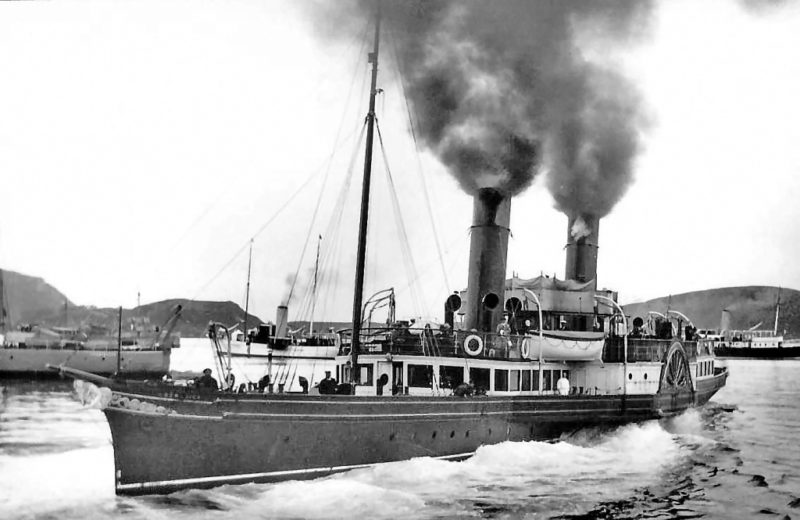
The main MacBrayne routes in the West of Scotland in 1890 included the following:-
Two splendid screw steamers, Claymore and Clansman, sailed from Glasgow to Stornoway on the ‘All the Way to Stornoway’ route via Mull of Kintyre, Sound of Jura and Sound of Mull to call at Oban and then on to Stornoway twice weekly. The ‘Trade Fair’ holidays each year in July saw large numbers of Lewis men returning home.
Two fast paddle steamers, Columba and Iona (3), on the daily ‘Royal Route’ service down the Clyde from Glasgow to Ardrishaig, then the small boat Linnet through the Crinan Canal to meet Chevalier for the run to Oban. The steamer Mountaineer then made two runs daily from Oban to Fort William and Banavie, with the steamers Gondolier or Glengarry (ex Edinburgh Castle) running up Loch Ness to Fort Augustus and Inverness. Two larger screw steamers, Cavalier being one, operated on the longer sea route via Mull of Kintyre, Sound of Jura, to Oban and Fort William carrying both passengers and heavy cargo. Another steamer, Gondolier or Glengarry, continued the voyage from Fort William and Banavie to Fort Augustus and Inverness.
A daily steamer sailed from Oban for Tobermory on Mull and intermediate ports.
A daily steamer sailed from Portree (Skye) for Stromeferry on Loch Carron with passengers taking the Dingwall and Skye Railway train onward to Inverness.
A daily steamer sailed from Stornoway for Stromeferry on Loch Carron with passengers taking the Dingwall and Skye Railway train onward to Inverness.
There were also direct runs to Lochinver (Sutherland), Loch Maddy (North Uist) from Skye, Lochboisdale (South Uist) from Oban, Castlebay (Barra) from Oban, Tarbert (Harris) from Skye, and also to Islay, and to Ullapool on the mainland.
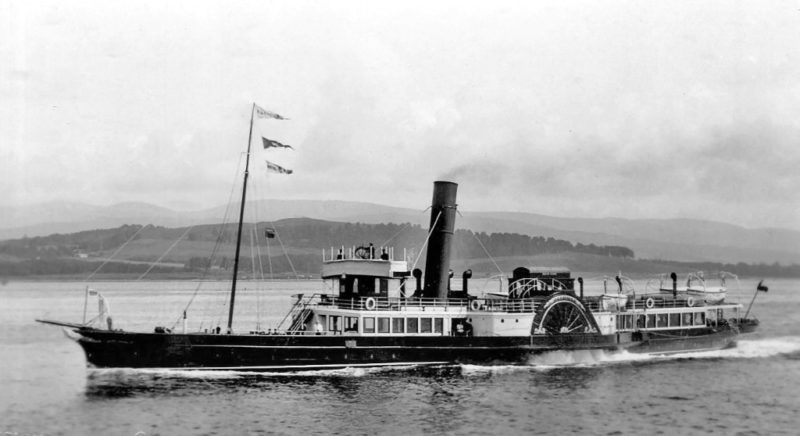
Clydesdale collided with the Swedish steamer Noreg while coming alongside the wharf at Stornoway on 1st July 1893. Noreg was loading herrings for the Baltic and was struck on the port bow and carried away her jib boom and pierced a hole in her hull. Clydesdale also fouled her propeller at Kyle of Lochalsh in March 1898, which detained her for four hours. She carried a detachment of troops from Fort George near Inverness from Kyle of Lochalsh to Stornoway in October 1903, and then left for her last annual overhaul in Glasgow as she stranded on the Lady Rock in 1904 and was then broken up. Lochiel ran aground on Harris in September 1893 while on passage from Portree to Dunvegan and Harris and was beached at Rodel harbour. Clansman (2) ran aground in early April 1898 on the Badcall Rocks in Sutherland and took a considerable amount of water in the engine room but her saloon remained dry. Pumps were sent on the Glasgow steamer Rob Roy from James Watt Dock at Greenock and the vessel was refloated. Claymore struck an underwater rock in Loch Torridon in April 1899 and was making water with damage to her bow and could not proceed to Glasgow, with her passengers transferred to another steamer. Claymore also had a collision in July 1903 below Cloch Lighthouse with a Clyde Trust hopper barge, with several plates aft on Claymore being stove in by the impact. Claymore had also suffered a serious accident in July 1893 on passage from Stornoway to Glasgow.
Several slightly larger screw steamers were then built or acquired by MacBraynes from 1890 to 1910 including Hibernian of 334 grt purchased in 1894 but built in 1875, Lapwing of 211 grt in 1903, Sheila for the Stornoway run of 280 grt in 1904, Plover (3) of 229 grt in 1904, Cygnet of 201 grt in 1904, Pioneer (2) of 241 grt in 1905, Clydesdale (2) of 412 grt in 1905, Chieftain of 1,088 grt in 1907, Lochinvar of 216 grt in 1908, Lochiel of 241 grt in 1908, and Dirk of 188 grt in 1909. Fast passages were made by Sheila e.g. a run of four hours and 47 minutes from Kyle of Lochalsh to Stornoway. Many sailings from Stornoway were sad as many Lewis men and their families were emigrating to Canada, a sailing in February 1907 had around 130 men leaving to work on the railways of Canada.
The elegant clipper bowed Chieftain of 1,088 grt with black hull and white upperworks was launched on 13th May 1907 at Ayr, with her trials taking place in July. She entered service from Glasgow to Oban, Tobermory, Loch Scavaig, Loch Hourn, Loch Duich and Loch Torridon, returning via the Sound of Sleat or West Skye to Glasgow on her weekly service. Circular tours of Skye and the West Highlands were offered in the summer of 1907 by Chieftain, Claymore, Clansman (2) and Cavalier. However, Chieftain did not meet her contracted speed of 14.5 knots, and the long dispute with her builders landed up in a court action for alleged breach of contract that was settled in March 1910, with her builders receiving £1,650 and MacBraynes the sum of £1,500 in respect of the final unpaid bill for the vessel.
Claymore grounded on the north east point of Pabba Island near Broadford on Skye while on a voyage from Glasgow to Stornoway at 0633 hours on 22nd January 1910 and took in water in her after hold and engine room. Pumps were sent from Greenock on a tug on 24th January and she was towed off on 29th January and the intention was to beach her on the east side of Broadford pier. The tow rope then parted at the last minute and she ended up listing heavily on the south west corner of the pier. The crew of 31 and 14 passengers were unhurt, and the certificate of the Mate was suspended for four months at the subsequent enquiry.
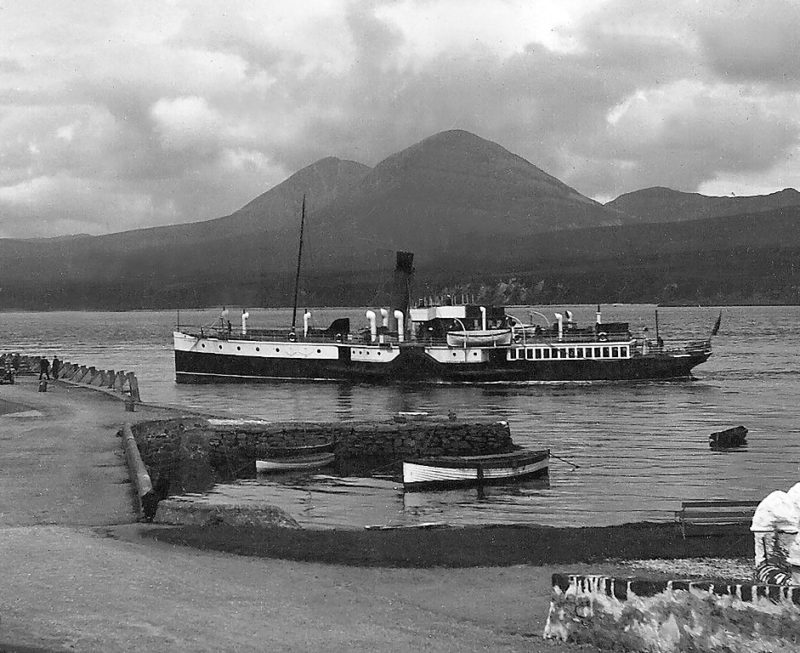
Chieftain grounded at the end of August 1911 on rocks between the islands of Raasay and Rona to the east of Skye. She had on board 130 passengers on her regular voyage from Stornoway to Glasgow. A musical concert was being held in the saloon at the time of the grounding, but the passengers were ordered into the boats as the position of Chieftain was perilous. Many passengers were thoroughly soaked by torrential rain during the night when they were landed on the safety of a neighbouring island. Chieftain floated off on the high tide in the morning and the soaked passengers reboarded the vessel to Portree. The damage to Chieftain was not serious and she resumed her voyage to Glasgow. She caught fire later in 1914 at her lay up berth at Lancefield Quay in Glasgow, with the fire crews experiencing great difficulty in getting on board the vessel, and then also connecting up their hoses to fit on the appliances of the vessel. Many of her hull plates were buckled and the total damage was estimated at £7,000.
Two vessels were lost on requisition for war service, Dirk by explosion in 1918, and Lochiel in July 1918 while acting as a fleet runner in the Bristol Channel. All of the main MacBrayne services to the Western Isles were maintained throughout the Great War, in a great credit to the company. Clyde Cargo Steamers Ltd. was formed in 1915 by three coastal Glasgow shipping companies to operate very small cargo ships to maintain supplies to the smaller Clyde ports, an arrangement that continued in World War II.
The David MacBrayne Ltd. fleet in 1920 numbered 23 vessels, the largest of which were the steamer Claymore of 760 grt built at Clydebank in 1881 by J. & G. Thomson, and the famous fast paddle steamer Columba of 602 grt from the same builders. The clipper bowed Chieftain of 1907 had been sold on 5th June 1919 to the North of Scotland, Orkney & Shetland Steam Navigation Co. Ltd. and renamed St. Margaret, and after further trading in Canada and the Mediterranean she was broken up at La Spezia in January 1952. The MacBrayne Head Office was at 119 Hope Street in Glasgow with four loading berths on the Clyde at Bridge Wharf and Lancefield Quay. The Chief Agents of the company numbered 22, and there were a further thirty railway station offices selling tickets for the steamers.
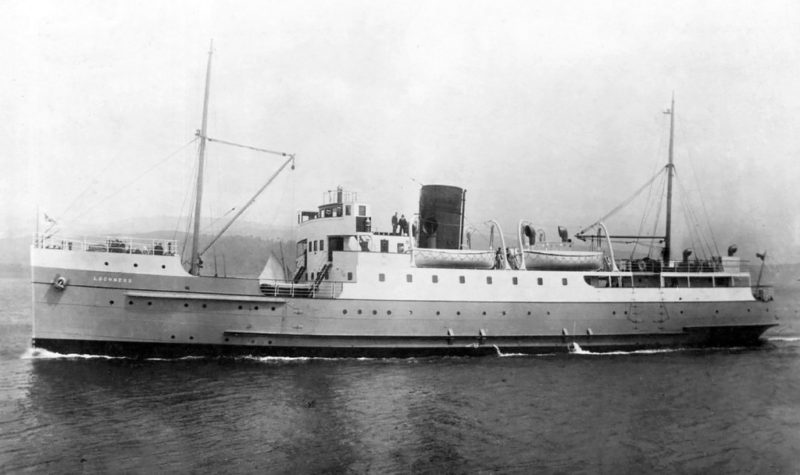
In addition, tickets could be purchased in England, Wales and Northern Ireland from a dozen companies and authorised ticket sellers. One screw steamer that was purchased in 1919 was Devonia of 326 grt and built in 1906 by Scott of Kinghorn Ltd. for English Channel service with management by Onesimus Dorey of Guernsey. She was renamed Lochiel (3) and worked the direct ‘All the way to Stornoway’ route and also on the Glasgow to Islay service when Clansman was required elsewhere, and also as a reserve steamer until laid up at Greenock in February 1937. She went back to English Channel service in October 1938 as Isle of Alderney for the Guernsey & Alderney Trading Co. Ltd. and after war service as a supply ship on the Clyde she served Greek and Italian owners in the Mediterranean.
The popular Stornoway steamer Sheila of 263 grt and built in 1904 was lost on 1st January 1927 when she grounded near Cuaig just south of the mouth of Loch Torridon after the Mate did not see the South Rona light while making his way south to call at Applecross on the mainland. This mistake is easy to make on the coasts of the West Highlands, but no lives were lost on this occasion.
DAVID MACBRAYNE (1928) Ltd.
David Hope MacBrayne, son of the founder, took over the reins of the company in January 1907 after the death of his father and founder of the company, both he and his brother Lawrence MacBrayne had been made partners in 1902 but Lawrence MacBrayne disposed of his interest two years later. David Hope MacBrayne successfully steered the company for over twenty years, but the lean times of the 1920s with the enforced economies proved too much, and he was forced in 1928 to sell the company to a joint bid from the London, Midland & Scottish Railway (LMS) and Coast Lines Ltd. MacBraynes had been adversely affected by the Scottish section of the LMS whose Western Isles services were subsidised by the Clyde profits. The main problem was the mail contract, which required regular sailings, even in winter, when there was insufficient passenger and allied goods to warrant the schedules. MacBraynes thus had no option but to withdraw its tender to carry the mails to the Western Isles in 1928.
The new management retained the MacBrayne name of the reconstituted David MacBrayne (1928) Ltd., but gave up the express passenger sailings and concentrated on the more sedate speed of the passenger and cargo steamers to the Western Isles and the remote inner coastal regions. The cargo only screw steamer Denbigh Coast of 411 grt and built in 1891 joined MacBraynes in May 1929 from Coast Lines and was renamed Lochdunvegan. The company regained its title of David MacBrayne Ltd. in 1936.

The new owners also invested in one steamer and five excellent motor vessels completed on the Clyde and at Ardrossan and Leith as the steamer Lochness (3) of 777 grt in July 1929, and the motorships Lochshiel of 208 grt in September 1929, Lochearn of 542 grt in July 1930, Lochmor of 542 grt in July 1930, Lochfyne of 754 grt completed in May 1931, and Lochnevis of 573 grt completed in April 1934. Three were twin screw motor vessels with Metrovick electric drive, but Lochshiel was single screw, and they were powered by either five or six cylinder diesel engines of up to 1,300 bhp to give service speeds of 14 to 16.5 knots. The steamer and the diesel engined quintet were used on the Stornoway mail service with Lochness replacing the hard worked Sheila built in 1904, with the motorships then using the longer sea route via the Mull of Kintyre to the Firth of Lorne to Oban, Mull, Skye, Loch Sunart and Loch Leven, with MacBraynes giving up completely on using the Crinan Canal. The Inner and Outer Hebrides islands of Eigg, Rhum, Muck, Canna, North Uist, South Uist, and Harris were also served by the new vessels, as well as the service to Fort William.

Lochness ran aground on New Year’s Day 1930 on Goat Island when leaving Stornoway harbour for Glasgow. She sustained damage on the port side which was making water and returned immediately to Stornoway and was beached with some of the mails soaked by seawater. The remainder of the mails were transferred to a fishing vessel which proceeded to Kyle of Lochalsh for onward movement by rail. The steamer Clydesdale arrived at Stornoway to convey the delayed passengers to the mainland.
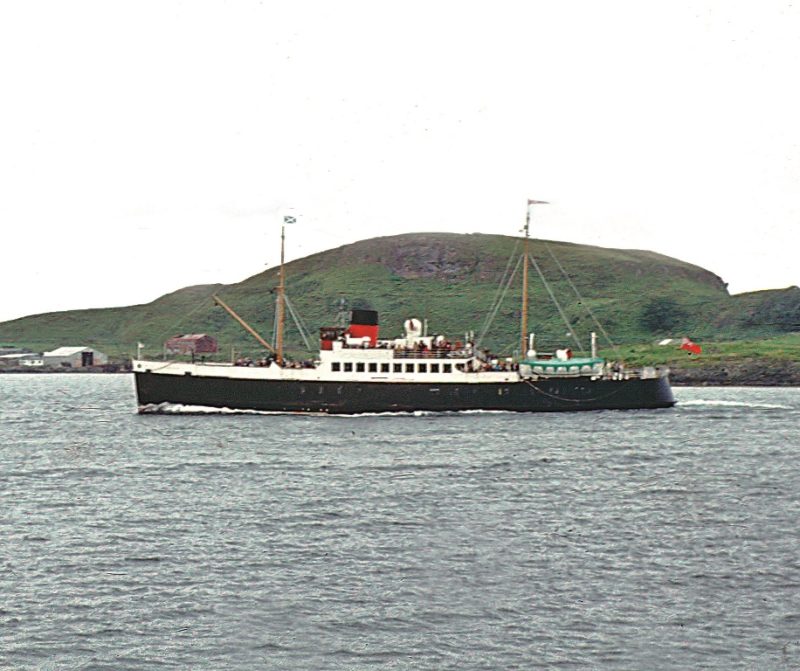
An iron hulled steamer was purchased in 1931 from the Aberdeen Steam Navigation Company after giving sixty years of service on the East Coast route between Aberdeen and London, and was renamed Lochbroom of 1,139 grt to replace the old Clansman, and she gave six more years of service to MacBryanes until broken up in July 1937 at Port Glasgow after 66 years of continuous arduous service. The size of the MacBrayne fleet in 1932 was 18 steam and motor vessels, with the elderly Lochbroom dating from 1871 being the largest ship in the fleet at 1,139 grt, and the oldest ships in the fleet were Iona built in 1864, Gondolier built in 1866, and Columba built in 1868. The Head Office of the company was now at 52 Robertson Street in Glasgow.
Two express turbine powered steamers joined MacBraynes on 3rd October 1935 after the takeover of Williamson-Buchanan Steamers Ltd. and Turbine Steamers Ltd. in association with the London, Midland & Scottish Railway. This pair were Queen Alexandra of 851 grt completed by Denny in 1912 and renamed Saint Columba by MacBraynes with power from three Parsons steam turbines, and King George V of 985 grt completed in 1926 also by Denny and powered by six Parsons steam turbines. Saint Columba was refitted before entering service and her twin red and black funnels were joined by a third funnel and a second mast, with King George V having twin funnels, and both were very impressive steamers when seen on the Clyde to Ardrishaig service or on summer excursions to Iona, with Saint Columba having her saloon extended aft. Saint Columba was converted to burn fuel oil in 1937, only the second MacBrayne steamer to do so, the first being Lochness of 1931. She served during World War II as a base for boom defence personnel in the East India Harbour at Greenock, and despite a grounding in Ettrick Bay on Bute in August 1953 she continued in service until sent for breaking up at the end of the 1958 season after 46 years of service. King George V became the last passenger steamer in service in September 1974 in the West Highlands, and she was sold in 1975 for service on the Bristol Channel as a restaurant ship until broken up at Cardiff in 1984 after almost sixty years of service.
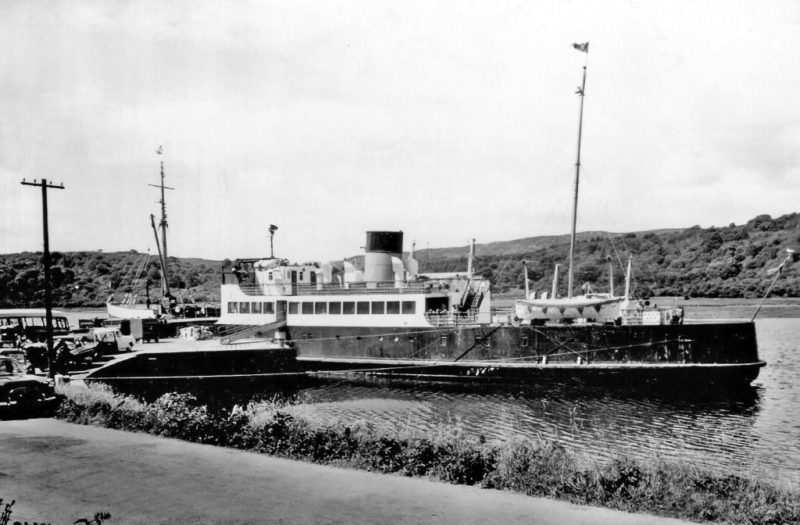
The Campbeltown & Glasgow Steam Packet Company formed in 1826 was absorbed in 1937. Two elderly Burns & Laird Lines screw steamers were transferred to MacBraynes in January 1937 in Lochgorm ex Lairdspool of 635 grt and Lochgarry ex Lairdsrock of 1,670 grt, the former dating from 1896 and the latter from 1898. Lochgorm was used on the Glasgow to Stornoway run, but this ceased after World War II began. Lochgarry was rebuilt at Ardrossan with completely new passenger accommodation and was given a new funnel before her entry into West Highland winter service and as a summer cruise ship in the same area, taking over from Lochbroom. She was unfortunately lost by foundering off Rathlin Island on 21st January 1942 while acting as a transport between Scotland and Iceland with the loss of over twenty lives. During the 1930s, some of the passenger fleet were repainted light grey, but the outcry from the devoted MacBrayne passengers was so great that the hulls were painted black again.
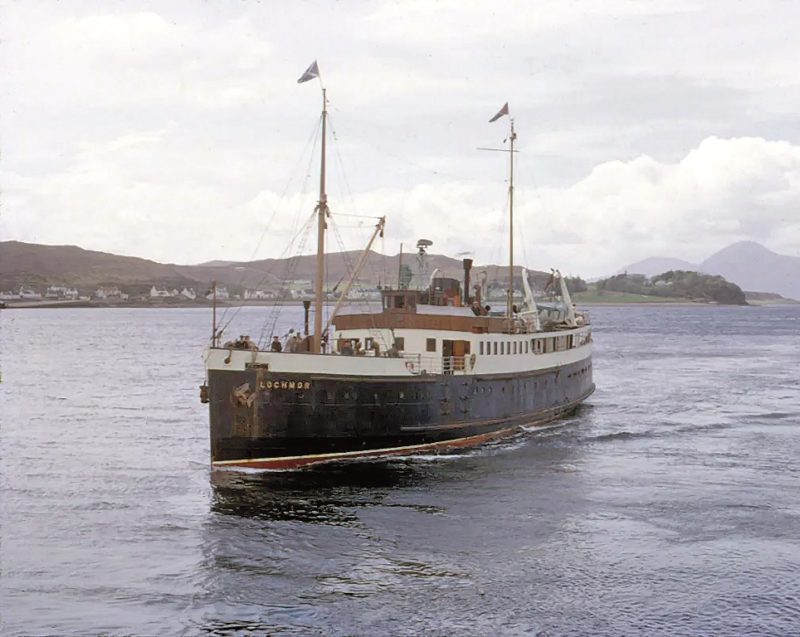
A new motorship was launched on 4th April 1939 at the famous Denny yard at Dumbarton as Lochiel (4) of 603 grt for the Islay service from West Loch Tarbert with extensions to Colonsay on occasion, her twin diesel engines of 440 bhp at 400 rpm driving twin screws through reduction gearing. The Main Deck had the First Class and Third Class dining rooms and smoking rooms, while Promenade Deck above had the comfortable Lounges, Purser’s office and ticket office. There was also a Shade Deck ‘midships above Promenade Deck and behind the navigating bridge, and a Lower Deck with accommodation for the officers and storerooms, with the crew accommodated in the fo’c’stle.
During World War II, the starting point of all Clyde based services was Wemyss Bay as a defensive boom had been placed across ‘The Narrows’ between Cloch Point and Dunoon, instead of Glasgow and Greenock. The services were to Ardrishaig, Lochgoil via Loch Long, Stornoway and the West Coast ports of Oban, Tobermory, Fort William, and Inverness via the Caledonian Canal in summer, as well as the inner islands from Mallaig, Skye ports and the Outer Hebrides. A dozen MacBrayne vessels were requisitioned for war service, and thus both the Stornoway and Portree services had to be suspended. A trio of the 1930s motorships operated at times between Wemyss Bay and Ardrishaig, and all of the other steamers and motorships performed herculean passenger, mail and cargo duties to the many West Highland islands without any respite for overhaul with only minor running repairs allowed, and little crew rest and recreation. There were no mishaps to the fleet that continued in service in Scotland in wartime, with three of the fleet being elderly in Gondolier of 1866, Loch Aline of 1904, and Pioneer of 1905.
MACBRAYNES IN POST-WAR YEARS (1946-1973)
The wartime fleet and that of the early post-war years had several chartered ships to make up the numbers required while ships were away or returning from long refits after the end of their requisition. These charters included Ulster Star of 576 grt and built in 1904 from the Belfast Steamship Co. Ltd. between 1944 and 1949, and Hebrides of 585 grt and built in 1898 from the rival West Highland fleet of McCallum, Orme fleet which dated back to 1873, when the Western Isles Steam Packet Co. Ltd. was set up. Hebrides was used on a special service between Oban and Tiree due to increased wartime traffic as an aerodrome was located there. This rival fleet was controlled by David MacBrayne Ltd. from October 1947 and was absorbed on 1st January 1948. Four vessels were taken over, with Hebrides sailing until she arrived on 1st August 1955 at Port Glasgow for breaking up, Dunara Castle of 457 grt and built in 1875 but withdrawn from service in June 1948 and sent for breaking up at Port Glasgow, Challenger of 151 grt and built in 1897 but withdrawn in November 1948 and broken up, and the small wooden launch Glassard built in 1918 and used as the Colonsay ferry until she foundered in April 1949.

Three vessels were chartered from J. & A. Gardner & Co. Ltd. of Glasgow, and Islander was chartered to act as a tender to the MacBrayne vessel at Loch Scavaig, and another vessel was chartered from a Helmsdale shipowner. The small passenger vessel Robina of 306 grt had been built in 1914 by the Ardrossan Dockyard for Morecambe Bay service and was acquired by Coast Lines in January 1946 for excursions from Falmouth but instead was chartered by MacBrayne in 1946/47 for local excursions from Oban, the West Loch Tarbert to Islay route, and for the Gourock to Lochgoilhead service. She was then chartered by Coast Lines in 1948 to the subsidiary Island Shipping Co. Ltd. but collided with and sank Herm Coast on 5th June 1949 while on a voyage from Guernsey to Sark. She was then sold to the Red Funnel Fleet of Southampton in August 1949 for service to the Isle of Wight until sold in August 1952 for breaking up at Rotterdam
In 1947, the private railway companies were nationalised, and the Clyde fleets of the LMSR and the LNER were amalgamated, and thus the half share in MacBraynes owned by the LMSR came under State control of the British Transport Commission. Several important vessels were either purchased or built for MacBraynes in the early post-war years in the new motor vessel Loch Seaforth of 1,126 grt launched on 19th May 1946 by Mrs. H. T. Leith and completed at the Denny yard on 19th May 1947, Lochbroom of 413 grt and formerly Empire Maysong of 1945, the Canadian built Loch Frisa of 519 grt, the Swedish built Lochdunvegan of 562 grt, Loch Carron of 683 grt completed in 1950 by the Ardrossan Dockyard, and the twin screw motor vessel Claymore of 1,024 grt completed in June 1955 by the Denny yard for the islands routes from Oban.
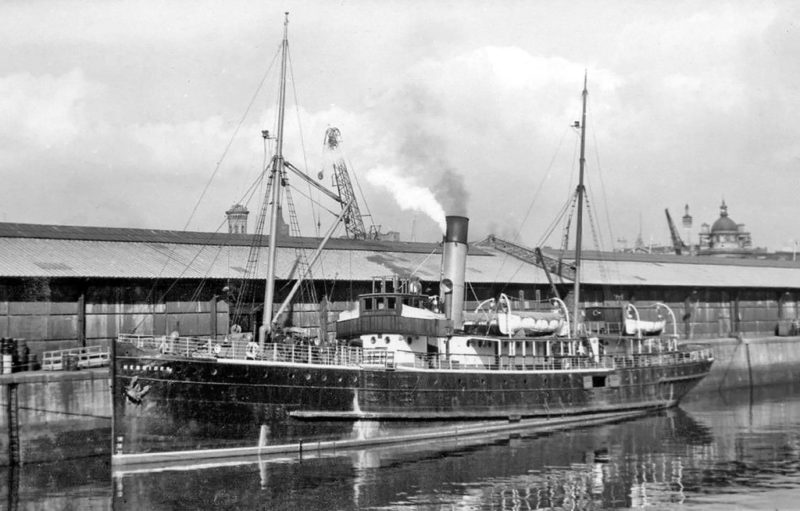
The 1950s saw MacBraynes win annual State subsidies (£360,000 in 1952) for their passenger, cargo and mail services of their twenty strong fleet sailing from Glasgow to Oban, Fort William, Inverness and the many islands of the Western Inner and Outer Hebrides. The centenary of the company was celebrated on 10th February 1951 with eighteen vessels of the fleet in harbour and at sea dressed overall with bunting, and the Chairman and four directors of the company attended evening celebrations. Lochshiel of 208 grt built in 1929 was sold on 4th January 1952 after all cargo services to small mainland ports north of the Kyle of Lochalsh were dispensed with in August 1951. The twenty vessels of the fleet in the late 1950s all had names beginning with ‘Loch’ except for the iconic twin funnelled King George V steamer of 985 grt dating from 1926 and Claymore of 1955. Their loading berth on the Clyde was Kingston Dock at Glasgow.
The former wooden inshore minesweeper Loch Arkaig of 230 grt and completed in 1942 was purchased towards the end of 1959 and entered service on 14th April 1960 on the Portree to Raasay, Kyle of Lochalsh and Mallaig run, transferring in 1964 to the Mallaig to Eigg, Muck, Rhum and Canna island service. However, what was concerning the minds of the MacBrayne directors at this time was the growing tide of private car ownership with the attendant wish by the travelling public to take their car with them to the Western Isles.
Three iconic early car carriers were then ordered by the company for the routes from Uig (Skye) to Lochmaddy (North Uist) and Tarbert (Harris), Mallaig to Armadale on Skye, and Oban to Craignure on Mull and Lochaline on the Morvern peninsula. The trio were built by the Hall, Russell yard at Aberdeen and named Hebrides (2) on completion in April 1964, Clansman (4) in June 1964, and Columba (2) in July 1964. They were of 1,420 grt and were chartered from the ownership of the Secretary of State for Scotland and were powered by twin eight cylinder Crossley diesel engines to give a service speed of 14.5 knots, and they were equipped with a bow thruster for harbour work. However, these were not ro-ro ships as the fifty cars were crane lifted on to a vertical lift to take them down to the garage with turntables for manoeuvring the cars. Their passenger capacity was 400 in winter and 600 in summer with sleeping berths provided for 51 passengers.
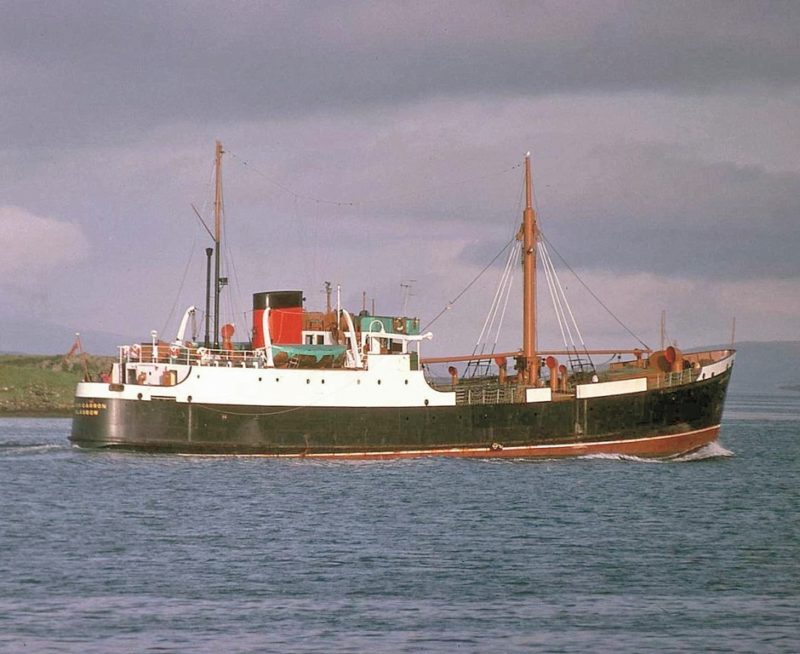
Loch Seaforth had taken up her run from Mallaig to Stornoway in December 1947 with superior accommodation for 500 First Class and Third Class passengers, with her Third Class lounge being much superior to that of First Class passengers on earlier vessels on the ‘All the Way to Stornoway’ route. She ran aground on 22nd October 1971 near Broadford on Skye and her 26 passengers were rescued by lifeboat and taken to Kyle of Lochalsh for onward journey by train to Inverness. She was then withdrawn from the Stornoway route and transferred to the Inner Isles mail and passenger service from Oban to Coll, Tiree, Castlebay on Barra and Lochboisdale on South Uist route in place of the younger Claymore of 1955.
Unfortunately, with the General Manager and Chairman of MacBraynes onboard, she ran aground on Clief Rock in the Sound of Gunna between Coll and Tiree on 22nd March 1973, and after refloating had to be towed to Gott Bay on Tiree. She had onboard eight passengers and 33 crew, who were rescued by fishing boats and a lifeboat and taken to the Scarinish Hotel in the village of Scarinish on Tiree. Capt. Gunn of Loch Seaforth blamed the absence of lights and the many treacherous rocks below the surface for the grounding. The vessel was badly holed and sank alongside Scarinish Pier and after refloating she was taken to Troon for breaking up. Shortly after this loss, Ullapool became the mainland port for Stornoway and was initially served by the motor vessel Iona of 1970 and the converted motor vessel Claymore of 1955. It should be noted that the tall Skerryvore Lighthouse a dozen miles south west of Tiree marks the limit that shipping should keep off the Inner Hebrides islands on their voyages up and down the main channel. It was built between 1838 and 1846 by Alan Stevenson and at 156 feet in height is the tallest lighthouse in Scotland.
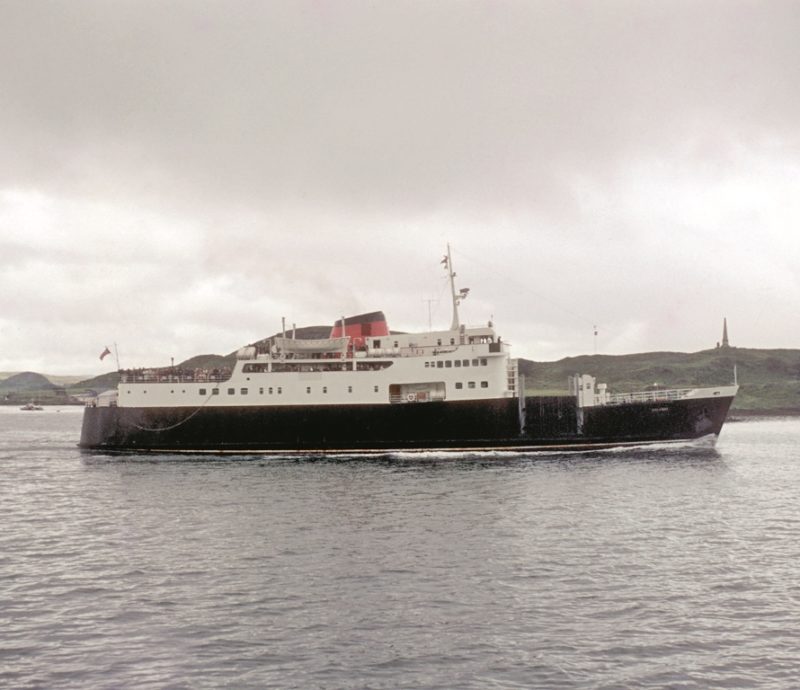
On 1st January 1969, the railway companies half share in MacBraynes was transferred to the Scottish Transport Group (STG), which had been formed to also own the bus and road haulage operations in Scotland, and in June 1969 STG also purchased the MacBraynes half share of Coast Lines. During 1969, 60,000 cars and 4,250 lorries were carried by MacBraynes, a five fold increase from five years earlier. A bow, side and stern loading ferry was completed by the Ailsa Shipbuilding yard at Troon in 1970 as Iona (7) of 1,138 grt and could carry 587 passengers and fifty cars or ten trucks, and was powered by English Electric Paxman diesel engines. This gave a MacBrayne fleet of fourteen vessels on 1st January 1973, the day that MacBraynes and the Caledonian Steam Packet Co. Ltd. were merged together as Caledonian MacBrayne Ltd. (Calmac). These ships were:-
Bruernish of 64 grt ordered for completion in 1973 carrying 50 passengers and 6 cars
Clansman of 1,707 grt built in 1964 as a crane lift car ferry and given ship surgery to increase capacity
Claymore of 1,024 grt built in 1955 carrying 500 passengers
Columba of 1,420 grt built in 1964 as a crane lift car ferry
Coll of 64 grt ordered for completion in 1973 carrying 50 passengers and 6 cars
Hebrides of 1,420 grt built in 1964 as a crane lift car ferry
Iona of 1,138 grt built in 1970 as a ro-ro ferry carrying 587 passengers and 50 cars
King George V of 985 grt built in 1926 carrying 1,432 excursion passengers
Loch Arkaig of 179 grt built in 1942 carrying 234 passengers in summer
Loch Carron of 638 grt built in 1951 as a cargo ship of 700 dwt
Lochnell of 31 grt built in 1941
Loch Toscaig of 49 grt built in 1946
Morvern of 64 grt ordered for completion in 1973 carrying 50 passengers and 6 cars
Rhum of 64 grt ordered for completion in 1973 carrying 50 passengers and 6 cars
The Head Office of Caledonian MacBrayne Ltd. (Calmac) was at The Pier at Gourock, and the Branch Offices were at Armadale, Fort William, Inverness, Kyle of Lochalsh, Lochboisdale, Lochmaddy, Mallaig, Oban, Port Askaig, Port Ellen, Stornoway, Tarbert (Harris), Tarbert (Loch Fyne), Tobermory on Mull and Uig on Skye.

POSTSCRIPT
MacBrayne passengers taking a passage down the Clyde ‘All the Way to Stornoway’, who had just returned from a long warm water cruise on Royal Mail Lines or P. & O. may have been forgiven for describing MacBrayne vessels as ‘very small’. Small they were indeed, but they carried out their arduous services in sometimes atrocious weather with only a few losses to maritime causes. All MacBrayne passengers took delight in the beautiful scenery of the West Highlands, away from the bustle of life in the big cities, with glorious sunsets over empty golden beaches. There was also a profusion of rare wildlife, and very long daylight summer days in which to enjoy it. The Hebrides are described in their own Gaelic language as ‘Tir nan og’ or ‘Land of the Ever Young’. I know from my own travels to Barra, Skye and on the Lower Clyde with MacBrayne that they give the traveller access to some very special places indeed.




Comments
Sorry, comments are closed for this item